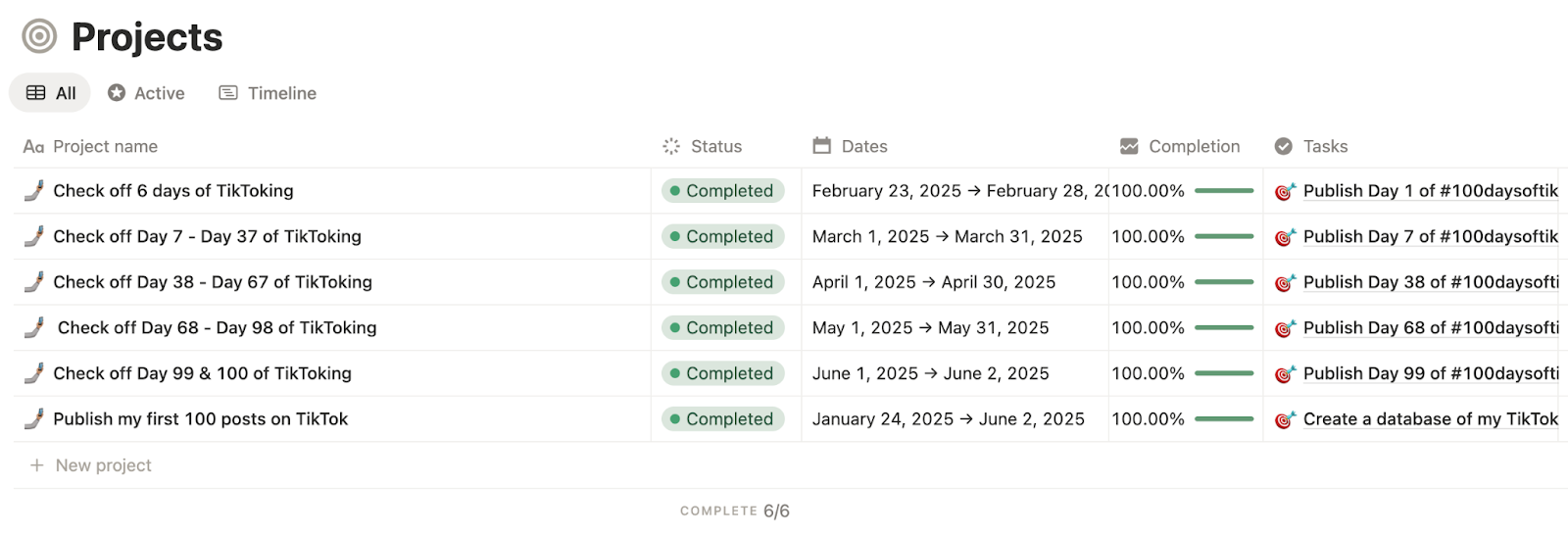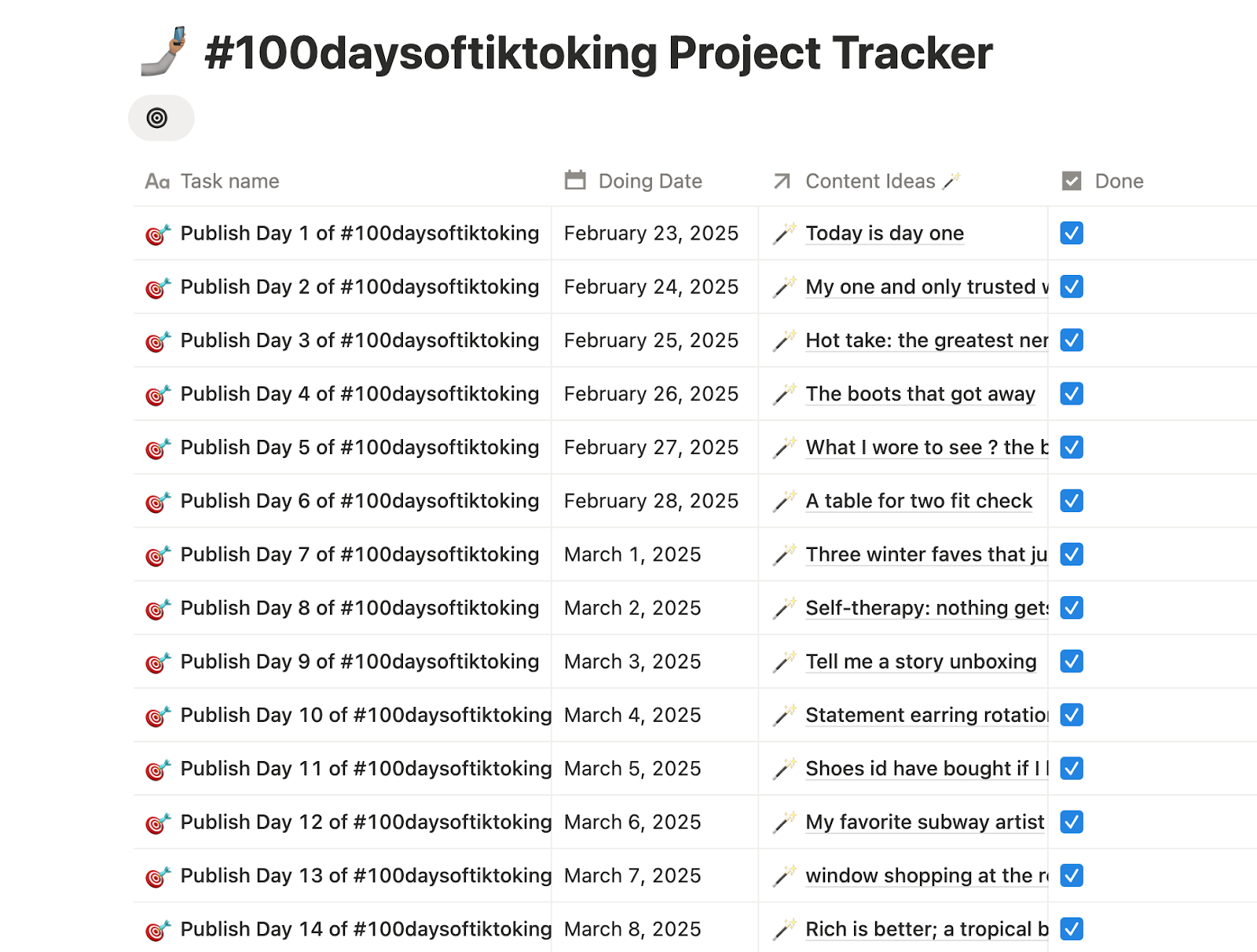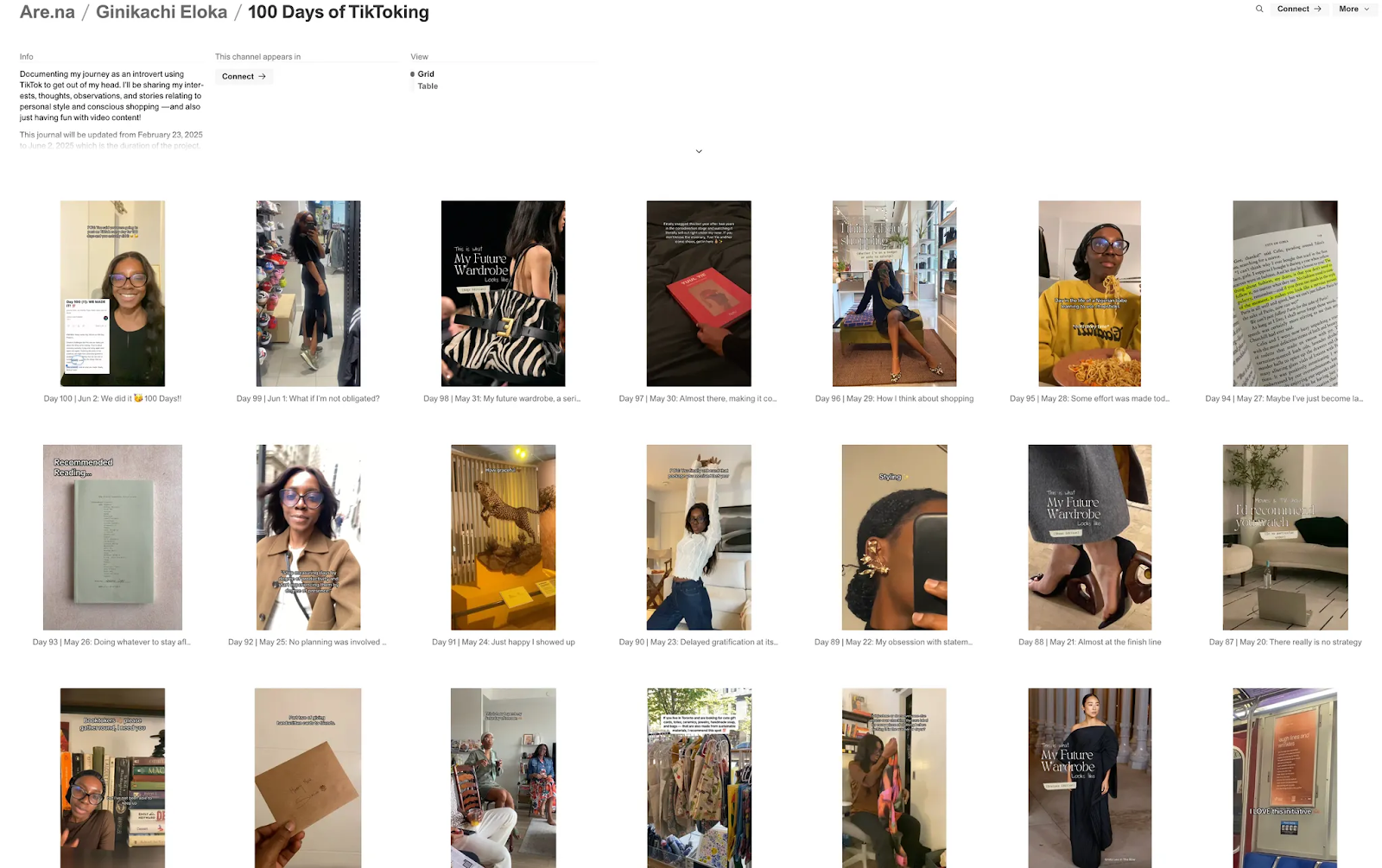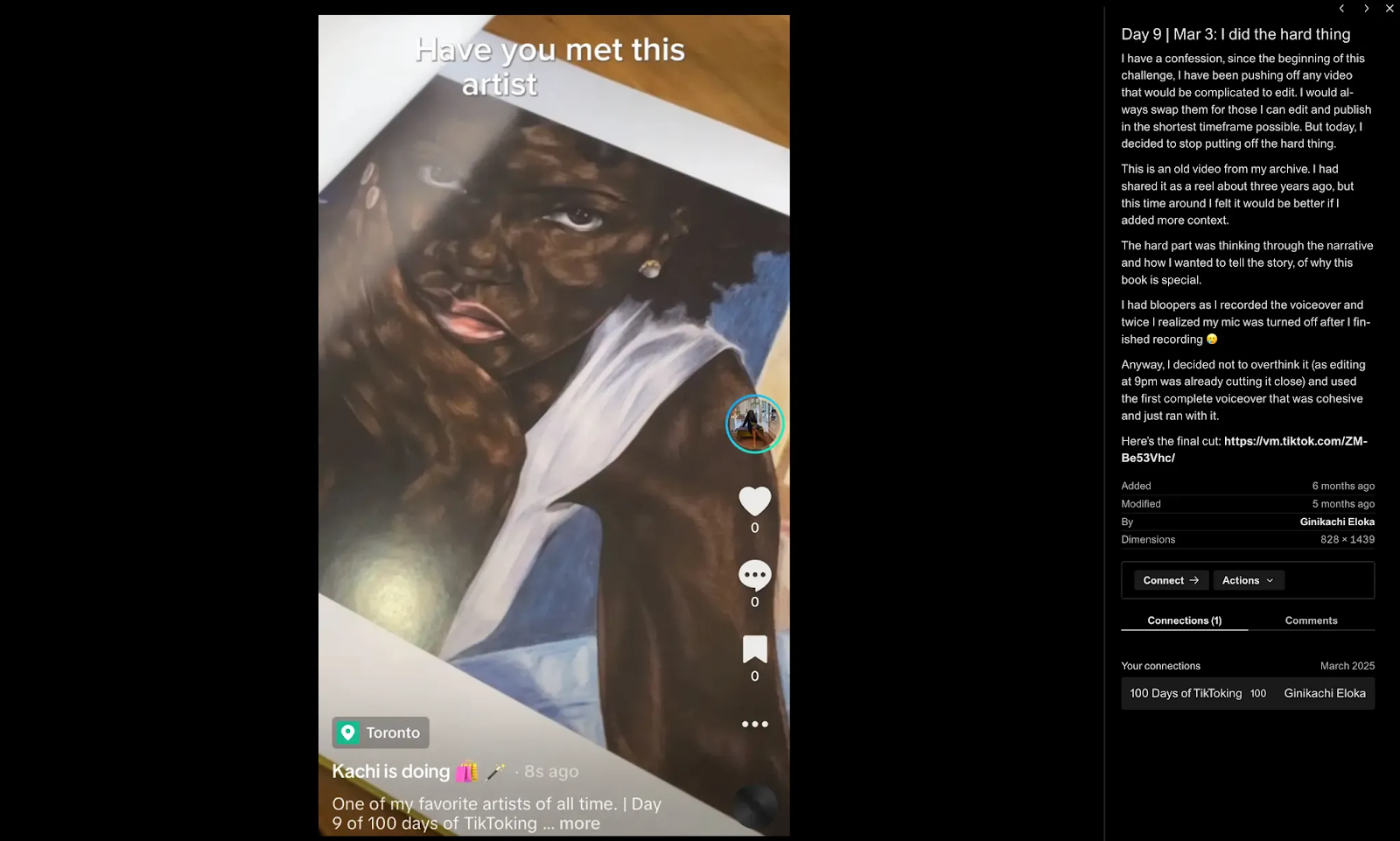I used to be a chronic overthinker, and it fueled my anxiety. Whenever I had to attend social gatherings, give a presentation, or even record a talking head video, my mind would spiral. I’d analyze every tiny detail until I was paralyzed, putting off the thing I intended to do.
That started to change when I joined the global 100-Day Project this year — and chose posting on TikTok as my challenge. I took it on specifically to push back against the anxiety of showing up online.
The more I showed up, the less I worried about being judged or coming off as “cringe.” Over time, I noticed a shift — I felt less anxious and stopped overthinking every move. Each post became a small act of courage — proof that I could show up without everything being perfect.
With a focus on consistency and not virality, I built a simple system to keep me on track. And it worked. I completed all 100 days, grew my TikTok views by 357% within 30 days, and, most importantly, became a lot less anxious about showing up online.
Here’s how.
What is the 100-Day Project?
The 100-Day Project is a free, global art challenge that encourages people to commit to a creative activity. It can be writing, dancing, drawing, crocheting, painting, anything, as long as you do it every day for 100 days and share your progress online along the way. The idea is simple: pick something, show up daily, and focus on the process rather than the outcome.
The challenge began as a grad school assignment for Yale students in 2007, created by designer Michael Bierut, and was later brought to social media in 2014 by artist Elle Luna.
Since then, it’s grown into a worldwide movement with hundreds of thousands of participants using the hashtag #The100DayProject to share their creative practice, stay accountable, and celebrate consistency.
I’d tried it once before – in 2021, I made my first attempt at the project with “100 Days of Bad Writing.” I wanted to write more and build the habit of sharing work even when it wasn’t perfect. But after the first two weeks, my consistency dwindled. Without a system to support daily creation, it just wasn’t sustainable. Four years later, the project is still unfinished.
This time around, I picked something different: “100 Days of TikToking”. My goal was to overcome the anxiety of being visible online by posting every day for 100 days and TikTok felt like the right space for it.
For me, doing the project this year was also an opportunity to get out of my comfort zone and finally do something I’d been meaning to for a while — share my ideas and interests publicly and confidently.
Laying the groundwork
A wise woman once said, “A project without a plan is just an idea — and you’ll never see the results.”
A plan is how you get from idea to implementation.
Before starting any project, I carve out time for what I call “project prep work.” It’s a mini planning sprint — a few hours spread out over several days — that helps me get ahead on all the little things that need to be done before a project officially begins.
Checking off simple things like scheduling daily tasks, updating my TikTok profile, and creating a database of content ideas — made the project feel much less overwhelming.

For this year’s 100-Day Project, I started planning about a month ahead. The official announcement came out on January 23, 2025, and the project was set to kick off on February 23.
In that announcement, project coordinator Lindsay Jean Thompson shared three reflection prompts to help with choosing a project:
- What would you love to make more space for in your daily life?
- What activities are lighting you up lately?
- Is there a skill you’ve been wanting to develop or something you’d like to learn more about?
These prompts helped me narrow down to: 100 Days of TikToking. This project was important to me because I wanted to practice articulating my thoughts, opinions, and perspectives on video as a way to quiet my social anxiety and build confidence in speaking publicly.
Alongside the prompts, Lindsay also outlined how the challenge works:
- Decide on a creative project to work on for 100 days before the start date.
- Starting February 23, show up daily. What counts as showing up is up to you.
- Document and share your progress online.
These guidelines shaped how I prepared. I used the weeks leading up to the challenge to map out what completing the challenge would take, set up the tools I knew I’d need, and remove as many small obstacles as I could before day one. That meant:
- Prepping my TikTok profile so I wouldn’t have to fuss with it later
- Organizing my iPhone albums so videos and photos were easy to find
- Scheduling my tasks in Notion so I wasn’t starting from scratch each day
- Lining up a few starter content ideas to avoid the “what do I post?” block
All of this became the foundation of the system that made showing up as easy as possible.
How I used AI to prepare
Before I shared my first post, I decided to ask ChatGPT for helpful TikTok tips. I had wanted to ask specifically for tips to optimize my posts, but decided to give it free rein.
I gave it context, my goal, and let it loose. Here’s the prompt I used:
I’m doing a 100-day TikTok challenge where I’ll be posting on TikTok every day for the next 100 days. It’s going to be my first time ever sharing content on TikTok. The goal is to document my journey as an introvert using TikTok to get out of my head. I’ll be sharing my interests, thoughts, observations, and stories relating to personal style and conscious shopping. Do you have any tips for me?
Compared to Perplexity and DeepSeek, which I also queried, ChatGPT gave me the most resonant and practical advice.
Here are the top five tips:
- Start simple – You don’t need high production value; just focus on getting comfortable showing up daily.
- Lean into your strengths – If speaking on camera feels intimidating, start with text overlays, aesthetic clips, or voiceovers.
- Engage with others – Comment on videos in your niche and respond to comments on your own posts.
- Don’t chase perfection – Done is better than perfect! TikTok rewards consistency more than polished content.
- Have fun & stay curious – This is an experiment, so embrace the journey and enjoy the process!
Building the system that made it possible
Once my prep work was done, and I had a clear view of the path to my goal, it was time to set up the system – something that made showing up effortless.
Planning my schedule around the official timeline
Considering how much time I was investing and to keep things manageable, I built the project directly into my existing Projects database in Notion and titled it: “Publish my first 100 posts on TikTok.”
Because I plan projects monthly, I broke the 100 days into monthly chunks so they would fit seamlessly into my regular workflow:
- Days 1–6 in February
- Days 7–37 in March
- Days 38–67 in April
- Days 68–98 in May
- Days 99–100 in June

Breaking it down this way also gave me clear milestones and made the challenge feel less overwhelming.
Within each monthly project, I created daily tasks (for example, “Publish Day 38 of #100DaysOfTikToking”) in my existing Tasks database. For each task, I set a “doing date” — the specific day I planned to work on that task — so it aligned with the official challenge timeline.
Building a content ideas database
Next, I created a database of content ideas. I knew if I had to think of an idea from scratch every single day, I’d eventually run out.
This space became my central brain dump to capture, organize, and iterate on ideas before creating.

Each entry included:
- The core idea
- A format label (e.g., video journal, nano-form video, highlight reel) to guide how I’d execute it
- A status column to track whether I was researching, editing, or had published it
- A two-way relation to my Tasks database, so I could assign an idea to a specific publishing day
- Space to draft video scripts, store research notes, write captions and hashtags, and plan creative direction — even down to specific music choices (e.g., for one post, Come with me to art Toronto, I used Beethoven’s Sonata No. 17)
I collected 119 ideas and ended up using 36 of them for my 100 posts. The rest came together more spontaneously, but having a backlog waiting in my database made it so much easier to show up consistently.
Creating a project tracker
To keep everything visible at a glance, I built a checklist-style project tracker in Notion, seamlessly linked to my content ideas database and tasks database.
Each row represented a day in the challenge, showing:
- The task name (for example, Publish Day 14 of #100DaysOfTikToking)
- The “It’s almost day 40, and honestly, just glad for every day I push through and put out something.doing' date to mark the specific day I planned to post
- A relation to the content idea assigned to that day
- A checkbox to mark when the post was published

This tracker helped me see what was coming up next and how many days I had left to go.
Journaling daily on Are.na
To document my progress and stay accountable, I started a public Are.na journal where I shared daily reflections and my thought process behind each post. I set this up so friends without TikTok could follow along, but it also became a reflective tool.

Here’s the format I used:
- Cover image: something that represented that day’s post (sometimes a frame from the video)
- Title: E.g., Day 1 | Feb 23 — [5-word summary of today’s post]
- Description: made up of morning pages-style notes to capture my thought process or commentary for the day — or data like views, likes, or engagement numbers
- Link: a direct link to the TikTok post
Tracking my time in Clockify
Lastly, I tagged the project in Clockify so I could track how much time I spent on different parts of the process. I mainly wanted to see how long each task actually took, partly out of curiosity, but also to help me allocate time better for future tasks.
The data wasn’t perfect. Some entries were missing because I was logging on the go, or inflated because I’d get distracted mid-task. Still, the overall picture was eye-opening.

A former manager used to nudge me often to track my time, and I always struggled with it. But now that I’ve gotten the hang of it, I can’t imagine working without it.
How I made it through 100 days
Before I started, I set a few rules for myself: keep it simple, stay lo-fi, and don’t overthink. The only way through was to reduce friction. That meant taking the shortest path to completion instead of aiming for elaborate production.
My goal was to practice storytelling, articulating my thoughts, and experimenting with video editing. Nothing more grandiose than that. These principles became my guardrails for the 100 days.
Daily practice: create → publish → log it
My daily workflow was simple and straightforward, but it was the backbone of this project:
- Create: I didn’t schedule posts in advance because the project emphasizes daily practice. I created in the moment, using mobile tools like Canva and CapCut to lower the barrier. To keep assets organized, I used my iPhone’s photo albums as a lightweight digital asset manager. Each post had its own album, which made pulling photos and video clips for editing much easier.
- Publish: Once the content was ready, I dotted the i’s and crossed the t’s before hitting “post.” Each day brought something new — using creator search insights, finding a trending sound, or responding to a comment with a new video. I treated this stage like play, and that made the process a lot more enjoyable.
- Log it: Immediately after publishing, I created a journal entry in my Are.na log.

This three-step loop gave my days structure. No matter how the content performed, I always had a clear start, middle, and end — and that rhythm made it easier to keep going.
The accountability factor
I’m familiar with failure — I’ve tried many things and failed at several. But over the past year, I’ve learned that having support systems in place can make execution so much simpler.
My public journal on Are.na gave me a sense of external accountability, while close friends encouraged me along the way with their comments. One even promised me a reward if I finished, and on the hardest days, that little extra motivation kept me going.
But more than anything, I was accountable to myself. I’d made a promise to show up every single day, and keeping that promise mattered most.
Milestones and motivation
Bierut, who created the original 100-Day Project assignment, said that once people reach day 30 or 40, they often find a groove that carries them forward.
“Once people got about halfway, they had so much personal investment, and they had internalised the process enough, that there was a good chance they’d make it to the end.” — Michael Bierut
I found that to be true. Momentum built over time. Even on days when I struggled to publish a post, I knew that if I just kept going, I’d eventually cross the finish line.
For example, my journal entry for day 37 was titled, “I’m actually doing this thing.” It was March 31, and I wrote:
“It’s almost day 40, and honestly, just glad for every day I push through and put out something. Even on days like this when I narrowly miss the deadline.”
On day 50, I remember adding party emojis to my journal because making it halfway was worth celebrating.
One thing that also kept me going was knowing that as long as I created and posted something that day — no matter how random or unpolished — it counted toward my 100 days.
The results
I did it! 🎉 I set out to post on TikTok for 100 consecutive days — and I followed through.
Considering that I had attempted the 100-day project before and failed to complete it, I know that the biggest reason I made it to the finish line this time was the system I built.
Having clear tasks, a backlog of ideas, and a daily rhythm meant I didn’t have to rely on motivation or mood. Even on days when I couldn’t get out of bed, I could still open my tracker, create something simple, and check “Post on TikTok” off my to-do.
That consistency completely changed how I felt about being visible online. When I started, posting felt nerve-wracking. By the end, it felt much easier, I had become much more comfortable showing up online — and that was the real win for me.
The numbers were just a bonus. Still, they were encouraging, especially considering I was completely new to TikTok and rarely published personal videos even on my private Instagram. Even without optimizing for performance, I saw real growth.
In one particular week (April 27–May 3), my analytics showed:
- 15K post views — up 373% from the week before
- 1,414 likes — up 677%
- 99 comments — up 350%
- 156 shares — up 1,318%
- 201 profile views — up 253%
Ironically, those results came from a video I almost didn’t post. I had spent over an hour editing it and nearly overthought myself out of sharing it. The next morning, I woke up to discover that the video had quietly outperformed all my others.
It had a 12.7% engagement rate, compared to another trend-focused post with much higher views but only a 1.7% engagement rate.
That moment reminded me that showing up, more often than not, brings unexpected benefits, and that sharing what genuinely resonates with your audience is a better strategy than simply jumping on trends.
6 lessons learned from the 100 days of TikToking
Looking back on this challenge, here are the biggest lessons I’m taking with me.
If you don’t schedule it, you probably won’t do it
Passion projects don’t magically fit themselves into your day; you have to make space for them. I’ve abandoned many projects because life “got busy”. Now, I know: if it matters, it goes on the calendar.
I’ve become a lot more intentional about scheduling time for creative work — especially the things I’d usually dismiss because they aren’t “core work.”
One scheduling tip I learned from the author of Essentialism, Greg McKeown: add a 50% buffer to the time you think something will take. That extra space makes it so much easier to accommodate unexpected situations.
Consistency doesn’t mean “every day”
Posting daily is intense — and can lead straight to burnout. This project definitely built my content creation muscle, but it also taught me a valuable lesson: consistency doesn’t have to mean posting every day.
Find a pace you can actually sustain. That could be once a week, or every other Wednesday. Sticking to a realistic rhythm is far better than trying to do it daily and eventually burning out.
For the 100-Day project specifically, small, daily actions (30 minutes or less) are ideal.
Clarity comes from doing
You’ll never be 100% ready. The only way to learn is to start.
One reason I took on this challenge was to practice fleshing out narratives, editing videos on mobile, and telling engaging stories.
Trial and error became part of my process. Some days, I played with different formats like carousels, voiceovers, vlog-style clips, or green screen. Other times, I experimented with typography, custom graphics, and content themes.
The more I did, the more confident I became, and my capacity grew along the way.
After years of doubting my editing skills, it turned out all I needed was to start — and keep going.
Preparation is a winning strategy
The easiest way to win is to prepare. Once you’ve invested the time and effort up front, success becomes almost inevitable.
I was reminded of this lesson during the challenge on a day when publishing felt effortless. I’d already recorded and edited the video, drafted the caption and hashtags, set the cover image, and saved everything to my drafts. When it was time to post, all I had to do was click one button.
Of course, I did a quick last-minute check, but the day was easy to conquer because I had prepared all the ingredients ahead of time.
You can do hard things
We’re all capable of doing seemingly hard things, and as we do them, our capacity expands.
Early in the challenge, I often avoided videos with complex edits, swapping them for simpler ones I could finish quickly. On Day 9, I finally decided to stop putting it off and film a video essay about one of my favorite coffee table books.
It took several tries (and some mic mishaps), but I finished. And while it didn’t end up a top-performing video, it’s still one of my favorites.
A template to help you complete your own 100 days of creative practice
Throughout this challenge, my system made all the difference — and now, I’m turning it into a public Notion template so you can build your own 100-day practice too.
You don’t have to wait until the next annual #The100DayProject to get started. Your 100 days can begin any time — tomorrow, next month, or right now.
The template includes everything you need to plan your project, set your timeline, organize ideas, track your progress, and keep yourself accountable.
If you’ve ever struggled to stay consistent with a creative practice, this system gives you a clear structure to lean on, so showing up becomes easier day after day.
👉🏽 Here's a link to the Notion template. To use it, just click the 'duplicate' button on the top right. Explore it, add it to your Notion workspace, and start your own 100-day project.
More TikTok resources
Try Buffer for free
190,000+ creators, small businesses, and marketers use Buffer to grow their audiences every month.




